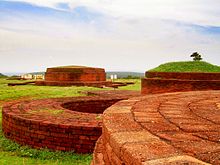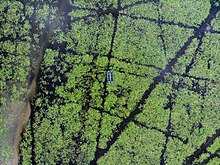Visakhapatnam (also known as Vizag, Viśākha or Wāltair)[5] is the executive capital of the Indian state of Andhra Pradesh. It is also the most populated and largest city of Andhra Pradesh.[6] It lies between the Eastern Ghats and the coast of the Bay of Bengal.[7][8] It is the third largest city in the east coast of India after Chennai and Kolkata and the fourth largest city in South India. It is one of the four smart cities of Andhra Pradesh selected under Smart Cities Mission.[9] Serving as the headquarters of its eponymous district, it is the most populous city in the state.[10][11][12] With an estimated output of $43.5 billion, the city is the ninth largest contributor to India’s overall gross domestic product as of 2016.[13][14] Visakhapatnam serves as the headquarters for the Eastern Naval Command.[15]
Sankaram

Stone seated Buddha at Bojjannakonda near Anakapalle
In 1907 British archaeologist Alexander Rea unearthed Sankaram, a 2,000-year-old Buddhist site. The name “Śankaram” derives from the Sangharama (temple or monastery). Located 40 km (25 mi) south of Visakhapatnam, it is known locally as Bojjannakonda and is a significant Buddhist site in Andhra Pradesh. The three major schools of Buddhism (Hinayana, Mahayana and Vajrayana) flourished here. The complex is known for its monolithic stupas, rock-cut caves and brick structures. The primary stupa was initially carved out of rock and covered with bricks. Excavations yielded historic pottery and Satavahana coins from the first century AD. At Lingalakonda, there are also rock-cut monolithic stupas in rows spread over the hill. The vihara was active for about 1,000 years.[citation needed]
Nearby is another Buddhist site, Bojjannakonda, with a number of images of the Buddha carved on the rock face of the caves. At Ligalametta there are hundreds of rock-cut monolithic stupas in rows, spread across the hill. Among other Buddhist attractions are a relic casket, three chaitya halls, votive platforms, stupas and Vajrayana sculptures.
Visakhapatnam’s history stretches back to the 6th century BCE, when it was considered a part of the Kalinga Kingdom, and later ruled by the Vengi, the Pallava and Eastern Ganga dynasties.[16] Archaeological records suggest that the present city was built around the 11th and 12th centuries with control over the city fluctuating between the Chola Dynasty and the Gajapati Kingdom,[17][18] until its conquest by the Vijayanagara Empire in the 15th century.[16] Conquered by the Mughals in the 16th century, European powers eventually set up trading interests in the city, and by the end of the 18th century it had come under French rule.[17][18] Control passed to the British Raj in 1804 and it remained under British colonial rule until India’s independence in 1947.
Bavikonda

Bavikonda stupas
Bavikonda is an important Buddhist heritage site located on a hill about 15 km, northeast from Visakhapatnam city. Here the Buddhist habitation is noticed on a 16 ha flat terraced area. The Hinayana school of Buddhism was practised at the monastery between the 3rd century B.C. and the 3rd century A.D. Bavikonda has remains of an entire Buddhist complex, comprising 26 structures belonging to three phases. A piece of bone stored in an urn recovered here is believed to belong to the mortal remains of the Buddha. The word Bavikonda in Telugu means “a hill of wells”. Fitting its name, Bavikonda is a hill with wells for the collection of rainwater. It is located 15 km (9.3 mi) from Visakhapatnam and is a significant Buddhist site. Excavation carried out from 1982 to 1987 revealed a Buddhist establishment including a mahachaitya embedded with relic caskets,[clarification needed] a large vihara complex, numerous votive stupas, a stone-pillared congregation and rectangular halls and a refectory. Artifacts recovered from the site include Roman and Satavahana coins and pottery dating from the third century BC to the second century AD. A significant finding was a piece of bone (with a large quantity of ash) in an urn, which is believed to be the remains of the Buddha. The Bavikonda site is considered one of the oldest Buddhist sites in Asia. It is a reminder of the Buddhist civilisation which once existed in southern India, and also reminiscent of Borobudur in Indonesia.[29]
Thotlakonda

Third-century BC Buddhist ruins of Totlakonda
About 16 km (9.9 mi) from Visakhapatnam is Thotlakonda, a Buddhist complex situated on top of a hill. The Buddhist complex on the Mangamaripeta hilltop, locally known as Totlakonda, lies about 16 km from Visakhapatnam on Visakhapatnam-Bheemili Beach Road. After its discovery (during an aerial survey), the Government of Andhra Pradesh declared the 48 ha site as a protected monument in 1978. Excavations in 1988 to 1992 exposed structural remains and artefacts, classified as Religious, Secular and Civil. These structures include the Stupa, Chaityagrihas, pillared congregation halls, bhandagaras, refectory (bhojanasala), drainage and stone pathways. The site covers an area of 120 acres (49 hectares), and has been declared a protected area by the government of Andhra Pradesh. Excavations have revealed three kinds of structural remains: religious, secular and civil. Structures include a mahastupa, sixteen votive stupas, a stone-pillared congregation hall, eleven rock-cut cisterns, well-paved stone pathways, an apsidal chaitya-griha, three round chaitgya-grihas, two votive platforms, ten viharas and a kitchen complex with three halls and a refectory (dining hall). Apart from the structures, Buddhist treasures excavated include nine Satavahana and five Roman silver coins, terracotta tiles, stucco decorative pieces, sculptured panels, miniature stupa models in stone, Buddha padas depicted with ashtamangala symbols (i.e. the eight auspicious symbols of Swastika, Shrivasta, Nandhyavarta, Vardhamanaka, Bhadrasana, Kalasha, Minyugala and Darpan) and early pottery.[30]
Later history
The territory of Visakhapatnam then came under the Andhra rulers of Vengi, and Chalukyas and Pallavas ruled the land. The region was ruled by the Eastern Ganga king– SuryaVamsa Kshatriyas and the Gajapati kings of Odisha from the 10th century to the 16th centuries AD (when the region came under the Visakhapatnam rulers). Based on archaeological evidence, the Prabhakar and the Eastern Ganga Kings of Odisha built temples in the city in the 11th and 12th centuries. The Mughals ruled the area under the Visakhapatnam Nizam during the late 15th and early 16th centuries. European merchants from France, Holland and the East India Company used the natural port to export tobacco, paddy, coal, iron ore, ivory, muslin and other textile products.
Local legend tells that an Andhra king, on his way to Benares, rested at Visakhapatnam and was so enchanted by its beauty that he ordered a temple to be built in honour of his family deity, Viśakha. Archaeological sources, however, reveal that the temple was probably built between the 11th and 12th centuries by the Cholas. A shipping merchant, Sankarayya Chetty, built one of the mandapams (pillared halls) of the temple. Although it no longer exists (possibly washed away about 100 years ago by a cyclonic storm), elderly residents of Visakhapatnam remember visits to the ancient shrine by their grandparents (although author Ganapatiraju Atchuta Rama Raju denies this).[31]
During the 18th century Visakhapatnam was part of the Northern Circars, a region comprising coastal Andhra and southern coastal Odisha which was first under French control and later British. Visakhapatnam became a district in the Madras Presidency of British India. In September 1804, British and French squadrons fought the naval Battle of Vizagapatam near the harbour. After India’s independence it was the largest district in the country and was subsequently divided into the districts of Srikakulam, Vizianagaram and Visakhapatnam.
Part of the city is known by its colonial British name, Waltair; during the colonial era, the city’s hub was the Waltair railway station and a part of the city is still called Waltair.

International Fleet Review 2016
On 7 May 2020, the city suffered an industrial accident when a polymer plant leaked toxic styrene gas, as it restarted operations after the Coronavirus lockdown. This gas leak killed at least eleven people, and drew comparisons to the Bhopal disaster.[32]
Geography

Kondakarla Ava, a bird sanctuary near Visakhapatnam
The city is situated between the Eastern Ghats and the Bay of Bengal.[7] The city coordinates lies between 17.7041 N and 83.2977 E.[3][4]
Climate
Visakhapatnam has a tropical wet and dry climate (Köppen Aw).[4] The annual mean temperatures ranges between 24.7–30.6 °C (76–87 °F), with the maximum in the month of May and the minimum in January; the minimum temperatures ranges between 20–27 °C (68–81 °F). The highest maximum temperature ever recorded was 42.0 °C (107.6 °F) in 1978, and the lowest was 20.0 °C (68 °F) in 1904. It receives rainfall from the South-west and North-east monsoons[4] and the average annual rainfall recorded is 1,118.8 mm (44.05 in).[33]
The city is home to the oldest shipyard and the only natural harbour on the east coast of India.[19] Visakhapatnam Port is the fifth-busiest cargo port in India, and the city is home to the headquarters of the Indian Navy’s Eastern Command and South Coast Railway zone. Visakhapatnam is a major tourist destination and is particularly known for its beaches.[20] It has been nicknamed the “City of Destiny” and the “Jewel of the East Coast”.[11] It has been selected as one of the Indian cities to be developed as a smart city under the Smart Cities Mission. As per the Swachhta Sarvekshan rankings of 2017, it was the third cleanest city
Well I truly enjoyed reading it. This subject offered by you is very constructive for accurate planning.
It’s a pity you don’t have a donate button! I’d most certainly donate to this excellent blog!
I guess for now i’ll settle for book-marking and adding your RSS feed to my Google account.
I look forward to brand new updates and will talk about this blog with my Facebook
group. Chat soon!